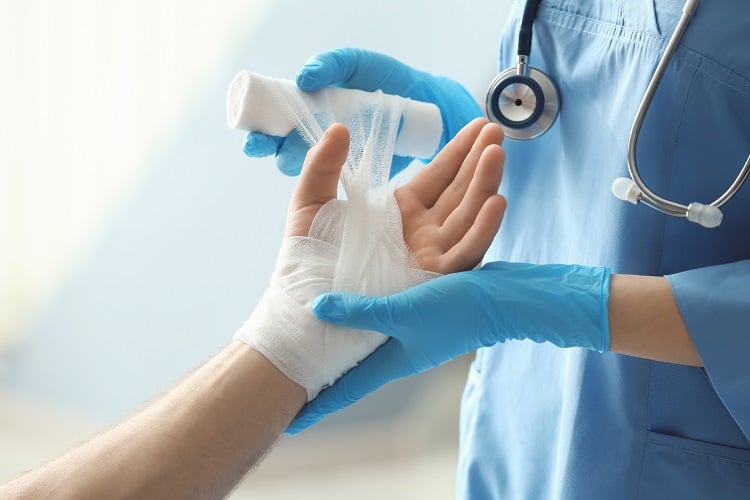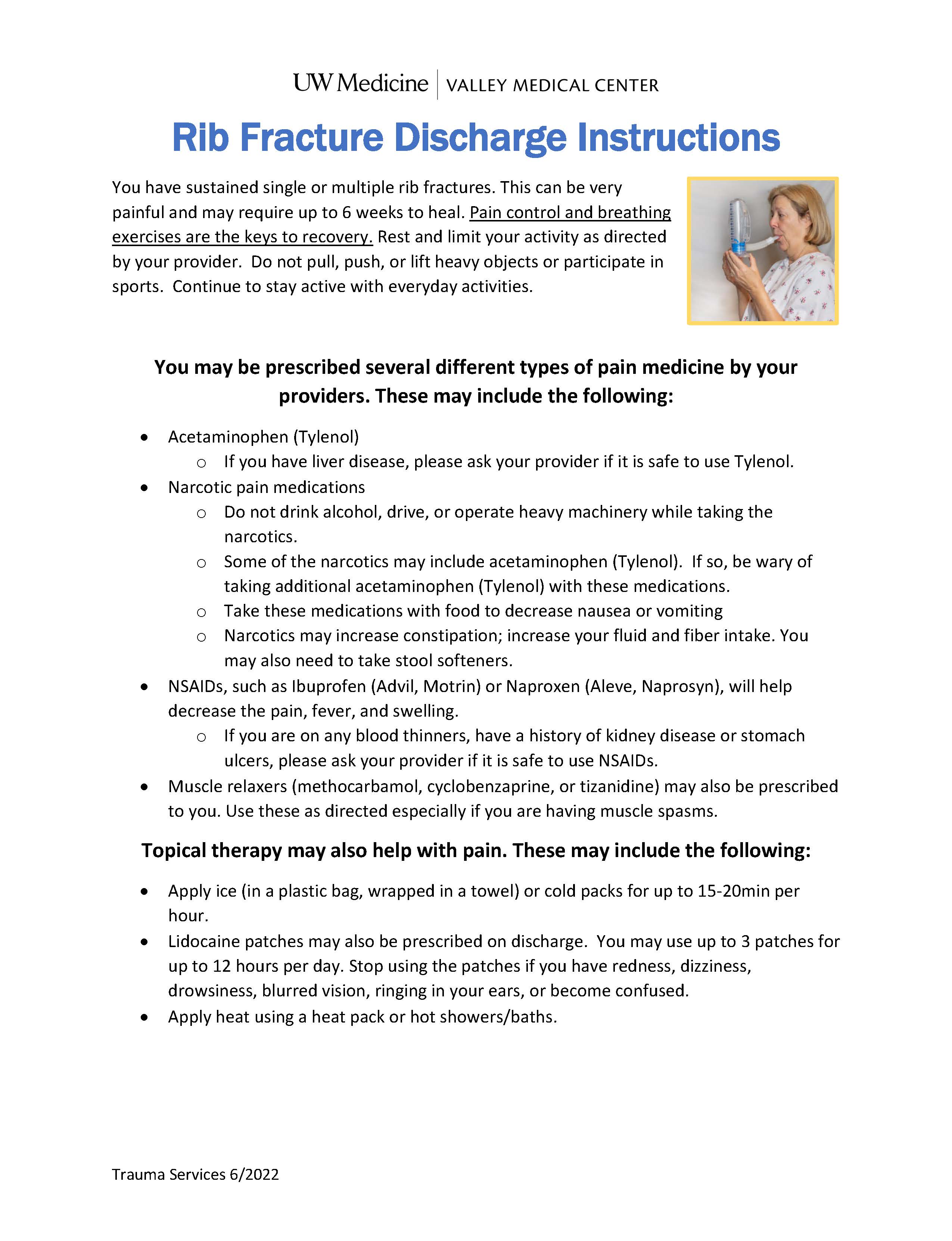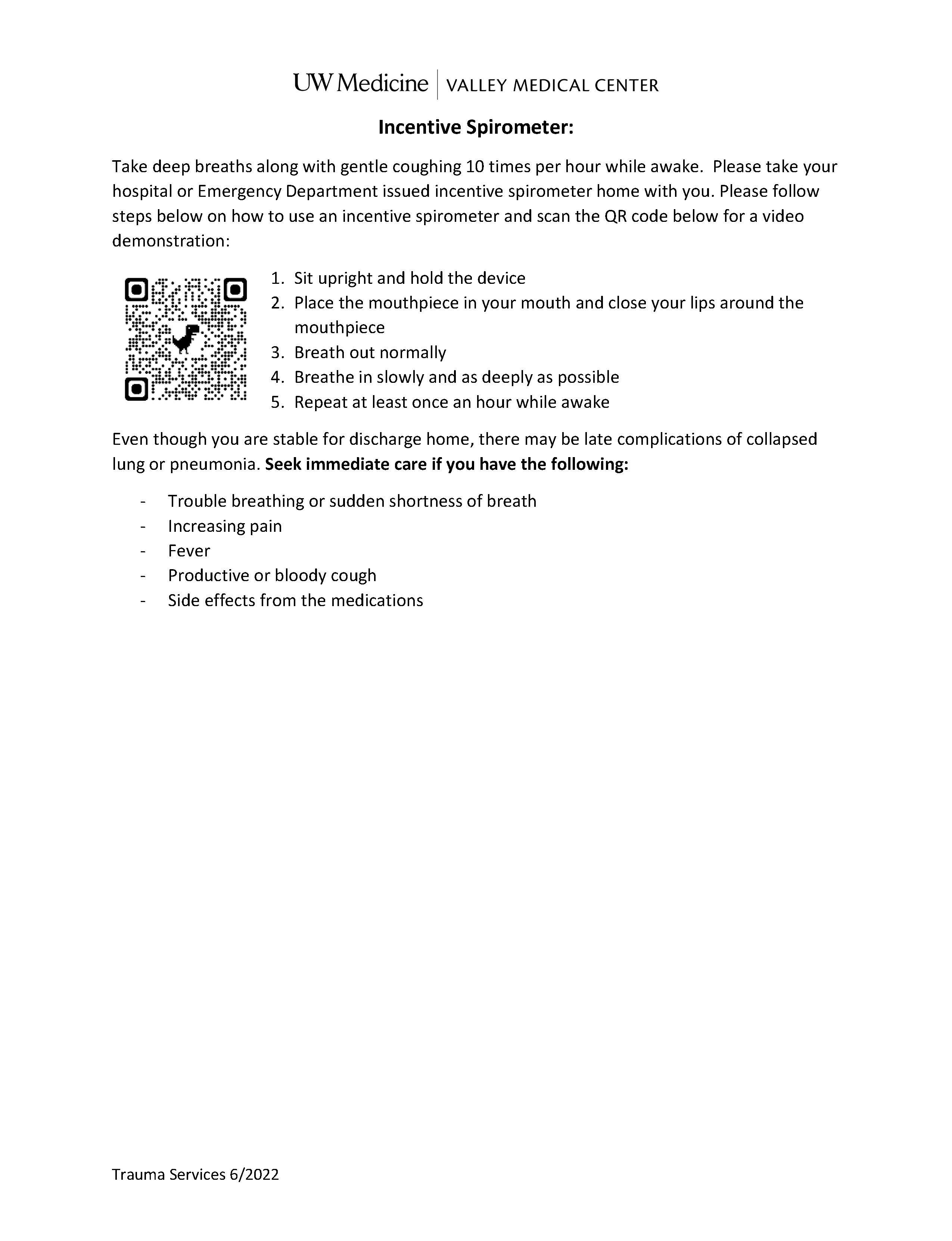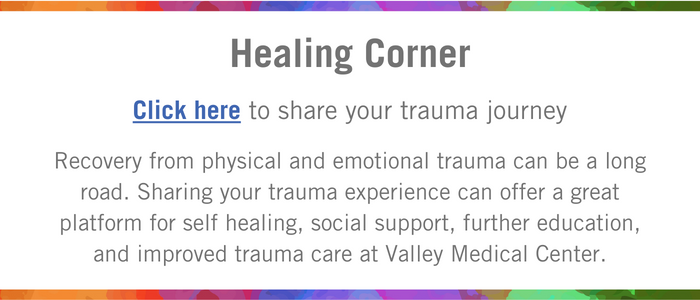Level III Trauma Center

Our Level III Trauma Center serves south King county. We are a moderate to high volume facility caring for a variety of injured trauma patients. This includes emergency, acute care surgery, and specialty surgery services with an operating room available 24/7.
As one of the busiest Level III trauma centers in the region, Valley provides exceptional care for injured patients and works closely with Harborview; the local Level I Trauma Hospital. We offer:
- 24-hour immediate coverage by emergency medicine, acute care surgeons, laboratory,
radiology, critical care services, operating rooms, and anesthesiology. - Other specialties include orthopedic surgery, neurosurgery, and OB/GYN
- Trauma prevention programs and continuing education programs for staff and the community.
- Injury prevention efforts with an active outreach program.
- On site blood bank
- Helipad
Click here to learn more about the care in our Emergency Department.
Learn more about what it means to be a Level III Trauma Center
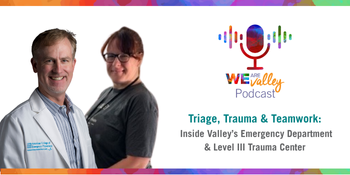 In this episode of the We Are Valley podcast, members of our Emergency Department team share what happens behind the scenes when every second counts. Hear how Valley became one of Washington’s busiest Level III Trauma Centers, what “Level III” really means for patients, and how our team works together to deliver expert, compassionate care when it matters most.
In this episode of the We Are Valley podcast, members of our Emergency Department team share what happens behind the scenes when every second counts. Hear how Valley became one of Washington’s busiest Level III Trauma Centers, what “Level III” really means for patients, and how our team works together to deliver expert, compassionate care when it matters most.
Click here or search "We Are Valley" in your favorite podcast platform to listen!
Top 3 Trauma-Related Methods of Injury
Patient Education Resources

Reduce Your Risk of Falling
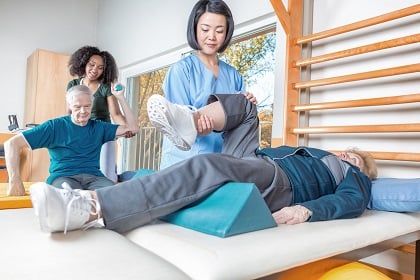 There are five key ways to reduce your risk for falls:
There are five key ways to reduce your risk for falls:
- Find fall dangers in your home and make changes to improve safety.
- Regular exercise and physical activity.
- Take good care of your eyes and make sure to have regular eye exams.
- Take good care of your feet, including wearing shoes that protect your feet.
- Review the medications you take for drug interactions and possible side
effects that may cause dizziness or loss of balance with your healthcare provider.
The resources below can help you learn more about preventing falls at home:
Valley Medical Center Resources
- Falls - Patient Education, Printable Packet
- Falls - Patient Education, Printable Packet (Spanish)
- Conquer the Fear of Falling with these Prevention Tips
- How to Prevent a Venous Thromboembolism (VTE)
Finding our Balance: Prevent Slips, Trips, & Stumbles
WA State Department of Social & Health Services
English | Spanish | Cambodian | Chinese | Farsi | Korean | Pashto
Laotian | Russian | Somali | Ukrainian | Vietnamese | Arabic
Mature Adult Legal Documents Assistance:
Seniors should prepare essential legal documents such as a Last Will and Testament, Durable Power of Attorney, Health Care Proxy, Living Will, POLST, and HIPAA Authorization. These documents help ensure their wishes are honored and provide peace of mind for both them and their families. Some of these you need a health care provider for, some you can do yourself, and some you will need legal assistance. Below are some links to help assist you:
- Getting Your Affairs in Order Checklist from the National Institute on Aging
- Portable Orders for Life-Sustaining Treatment (POLST) from the Washington State Department of Health
- Deal with Dignity Act from the Washington State Department of Health
More Fall Prevention Resources
- 6 Steps to Prevent a Fall by the National Council on Aging (1:40 video)
- Fall Prevention by Aging Wisely (26:38 video)
- Fall Prevention for Older Adults by the National Council on Aging
- Fall Prevention Program Locator - Sound Generations
- Fall Prevention Resources from the WA State DoH
- Falls Free Check-up by The National Council on Aging
- Low-Cost Exercise Program & Motivational Behavior Change Program for Seniors though Project Enhance - Developed by the University of Washington and Sound Generations
- Older Adult Falls by the WA State Department of Health
- Older Adult Fall Prevention by the Centers for Disease Control and Prevention
- One Step Ahead for a Healthy Independent Life by King County Public Health and Emergency Medical Services
- Senior Assistance Programs | Legal Help, Meals, Rides, & Fitness by Sound Generation's Senior Assistance Program
- Tips for Staying Active & Healthy Aging by the National Institute on Aging
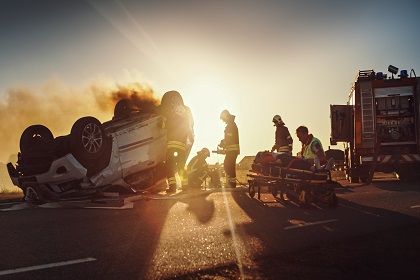 There are 3 main types of distracted driving:
There are 3 main types of distracted driving:
- Visual: taking your eyes off the road
- Physical: taking your hands off the wheel
- Mental: taking your mind off driving
The resources below can help you learn more about safe driving:
- Car Seat Safety to Protect Children by VMC
- Like Alcohol, Certain Medicine Can Affect Your Driving by VMC
- Transportation Safety by the Centers for Disease Control and Prevention
- Distracted Driving by the WA State Department of Health (0:32 video)
- Reckless & Distracted Driving by Impact Teen Drivers
- What Do You Consider Lethal? by Impact Teen Drivers
A few small precautions (from King County Public Health) can save a child's life:
 Always watch small children closely.
Always watch small children closely. - Never open windows more than 4 inches.
- Open windows from the top down, if possible.
- Move furniture away from windows.
- Install window stops or child-safety window guards.
- Never rely on window screens to keep children from
falling out a window. - Screens are designed to pop out for fire safety—the
weight of a toddler can easily push through a screen.
The resources below can help you learn more about keeping your
children safe from injuries at home, in and around the car, and at play:
- Summer is the Time to Check for Helmet Safety by VMC
- Safe Kids, Washington by the WA State Department of Health
- Window Safety for Kids by King County Public Health
Common Trauma-Related Diagnosis
Patient Education Resources

General Resources
- Burn First Aid Resources - American Burn Association
- General Burn Information - UW Medicine
- Types of Burns - UW Medicine
- Emergency Treatment of Burn Injuries - UW Medicine
- Burn Care Resources - UW Medicine
- Fire Safe Kid Resources - Burn Institute
- Home Fire Escape Plan Resources - Ready.gov
- Fire Prevention and Community Risk Reduction - U.S. Fire Administration
- Learn how sunscreen protects you from burns - Harborview Medical Center
- Pediatric Palm Burn Exercises and Activities - Harborview Medical Center
- Foot and Leg Burn Exercises and Activities - Harborview Medical Center
200 Series - For Providers & Patients
BURNS 201: Initial Care and Debridement of Outpatient Burn Wounds
BURNS 202: Activity and Stretching Exercises for Burn Patients
BURNS 203: Care of Your Mepilex Ag Donor Site at Home
BURNS 205: My First Wound Care
300 Series – Stretching for Patients
BURNS 301: Pediatric Palm Stretch
BURNS 302: Hip and Groin Stretches
BURNS 303: Burn Elbow Stretches
BURNS 304: Burn Shoulder Stretches
BURNS 305: Foot and Leg Stretches
BURNS 306: Burn Hand Stretches
BURNS 307: Wrist Stretching
BURNS 308: Neck Stretches
BURNS 309: Face Stretching
300 Serie En Español
BURNS 300‐S: Actividades y ejercicios de estiramiento para personas con quemaduras (Activity and Stretching Exercises for the Burn Patient)
BURNS 301‐S: Estiramiento de Palma Pediatrica (Palm stretching)
BURNS 302‐S: Estiramiento de la Cadera y la Ingle (Hip and Groin Stretches)
BURNS 303‐S: Estiramiento del Codo (Burn Elbow Stretches)
BURNS 304‐S: Estiramientos para Quemaduras del Hombro (Burn Shoulder Stretches)
BURNS 305‐S: Estiramientos para Quemaduras del Pie y de la Pierna (Foot and Leg Stretches)
BURNS 306‐S: Estiramientos de la Mano (Burn Hand Stretches)
BURNS 307‐S: Estiramientos de la Muñeca y el Antebrazo (Wrist Stretching)
BURNS 308‐S: Estiramientos del Cuello (Neck Stretches)
BURNS 309‐S: Estiramientos de la Cara (Face Stretching)
500 Series - Burn Pain for Patients
BURNS 501: Burn Pain: The Basics
Resource List
- Facial Fracture | At-Home Care from Valley Medical Center
- King County access & outreach program
- Dental and oral health clinics, programs, and resources from King County Public Health
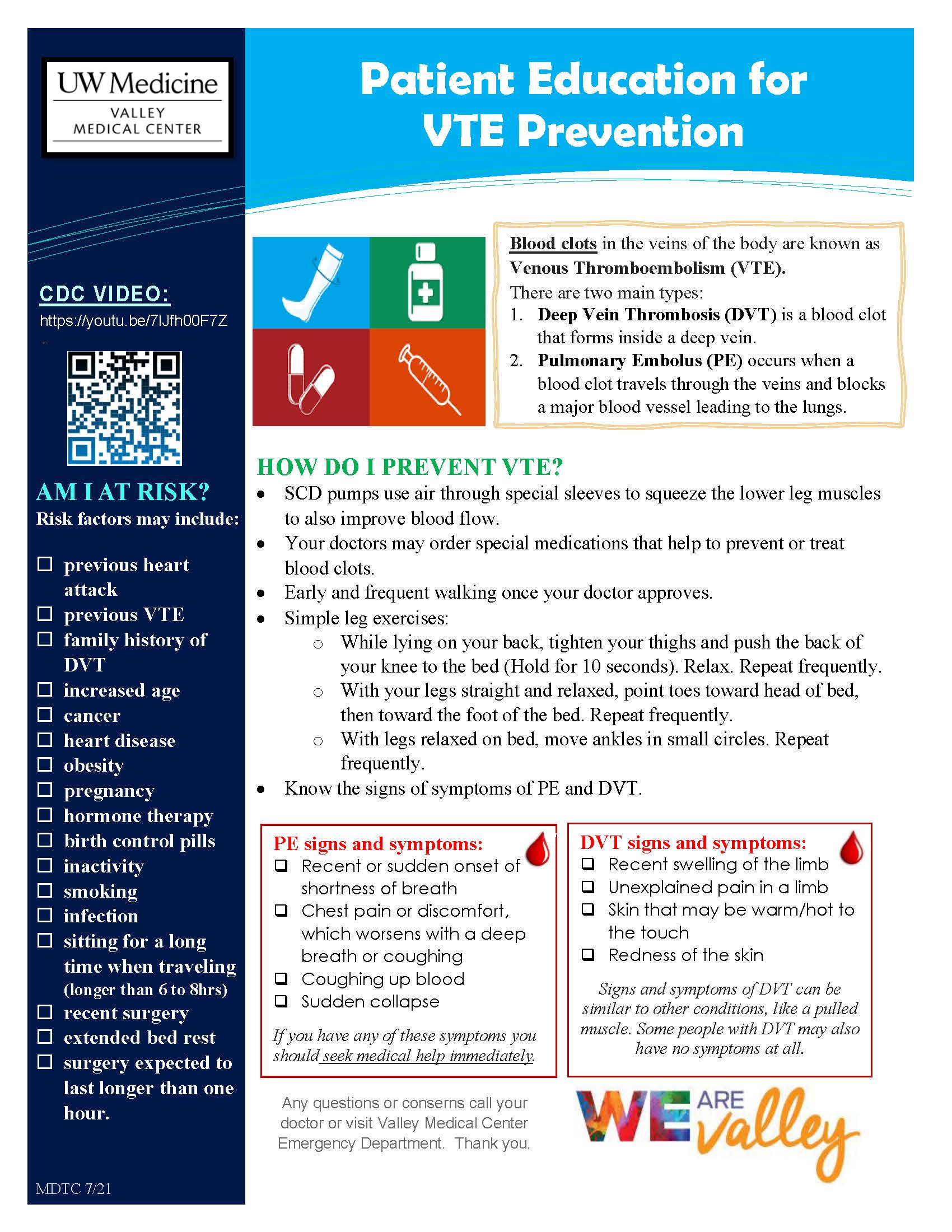
Click here to download a copy of this document
- Traumatic Brain Injury Resources & Workbook from the WA State Department of Social and Health Services
- Moderate to Severe Traumatic Brain Injury by UpToDate
- Traumatic Brain Injury Resources from the WA State Department of Social and Health Services
- What is a Traumatic Brain Injury? (3:32) Educational Video
- Help for a Traumatic Brain Injury in Washington State
- Events and classes for those with a TBI
- Learn more about TBI & Concussion from the CDC
- What to Expect After a Concussion from the CDC
- What to Expect After a Concussion (Wallet Card)
To get care for stroke patients, BE FAST. See the signs? Call 911.
A stroke is a brain attack, caused when an artery in the brain is blocked or bursts — and part of the brain starts to die. Patients with stroke symptoms are evaluated safely for both stroke and trauma at Valley. Patients with both symptoms of Stroke and traumatic injuries may fall under the collaborative classification of STRAUMA. Fast treatment is crucial for a better chance at survival with less disability. Know BEFAST and when to call 911 and let Valley take care of you or your loved ones.
Learn more about Stroke and Neurovascular Care here.
Find more stroke resources here.
Drug & Alcohol Resources
- FREE drug and alcohol self-exam by the National Institute on Drug Abuse
- Screening and Assessment Tools Chart by the National Institute on Drug Abuse
- List of behavioral health resources in South King County
- Medications for Opioid Use Disorder; list of resources
- Substance Use Disorder; list of resources
- Drug & Addiction Resources in Washington State
- Help Finding Treatment; FindTreatment.gov
- What's up with Fentanyl?; Educational flyer from UW Medicine
- Drug & Alcohol Hotlines
- Alcohol and Drug 24hr Hotline for WA State | (206) 722-3700, (800) 562-1240
- Teen line for WA State | (206) 722-4222, (877) 345-8336
- Addictions, Drug, & Alcohol Institute at UW Medicine | (206) 221-8325
- Crisis Connections 24hr Crisis Line | (866) 427-4747
- Alcohol and Drug 24hr Hotline for WA State | (206) 722-3700, (800) 562-1240
Sexual Assault Resources

- Sexual Health Clinic at Harborview
- Traumatic Stress Counseling - Harborview Abuse and Trauma Center
- Sexual Assault Hotlines
- Rape, Abuse & Incest National Network (RAINN) | 1-800-656-4673
- National Domesic Violence Hotline | 1-800-799-7233
- King County Sexual Assault Resource Center | 1-888-998-6423
- Sexual Assault Resources - University of Washington
- Sexual Assault, Domestic Violence, Dating Violence, & Stalking Resources - Washington State University
- Protection Orders - King County
- Steps for Filing for an Emergency Protection Order - King County
Trauma Services Community Outreach Programs
See all of Valley Medical Center's upcoming events here.
Trauma Nurses Talk Tough
Valley's Trauma Team, in partnership with Legacy Health in Oregon, is pleased to offer Trauma Nurses Talk Tough to area schools and community groups, to help people learn to avoid risk and stay safe.
Learn about Valley's Trauma Nurses Talk Tough.
Stop the Bleed
The #1 cause of preventable death after injury is bleeding. With 3 quick actions, you can be trained to save a life. Valley is proud to be one of many Stop the Bleed training sites throughout the US.
Learn about Valley's Stop the Bleed program.
SAGES Theatre
Valley's Trauma Team is pleased to partner with SAGES Theatre to provide fall prevention resources.
Learn about SAGES Theatre.
Falls Prevention Presentation now available.
“Steps Toward a Healthy and Independent Life: 6 Steps to Prevent a Fall.”
Falls are not a normal part of aging, yet half of all injury related deaths among WA residents aged 65 and older are due to unintentional falls. Most of those are preventable trips, slips and stumbles in the home. This presentation focuses on steps older adults can take to create their own plan for reducing fall risks and staying healthy, strong, and independent.
Length of Presentation: 40 minutes, Q & A additional 10-20 minutes
Target audience: Older adults 55+
Objective: This is a call to action for older adults to mitigate their individual fall risks. Awareness, knowledge, and behavior change. Includes 12 question Falls Risk Assessment Survey at the end of the presentation.
Adopted from the NCOA, “6 Steps to Prevent a Fall” this is presentation for our partners that work with older adult populations. To schedule please email Trauma_Services@valleymed.org

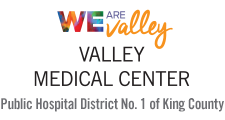
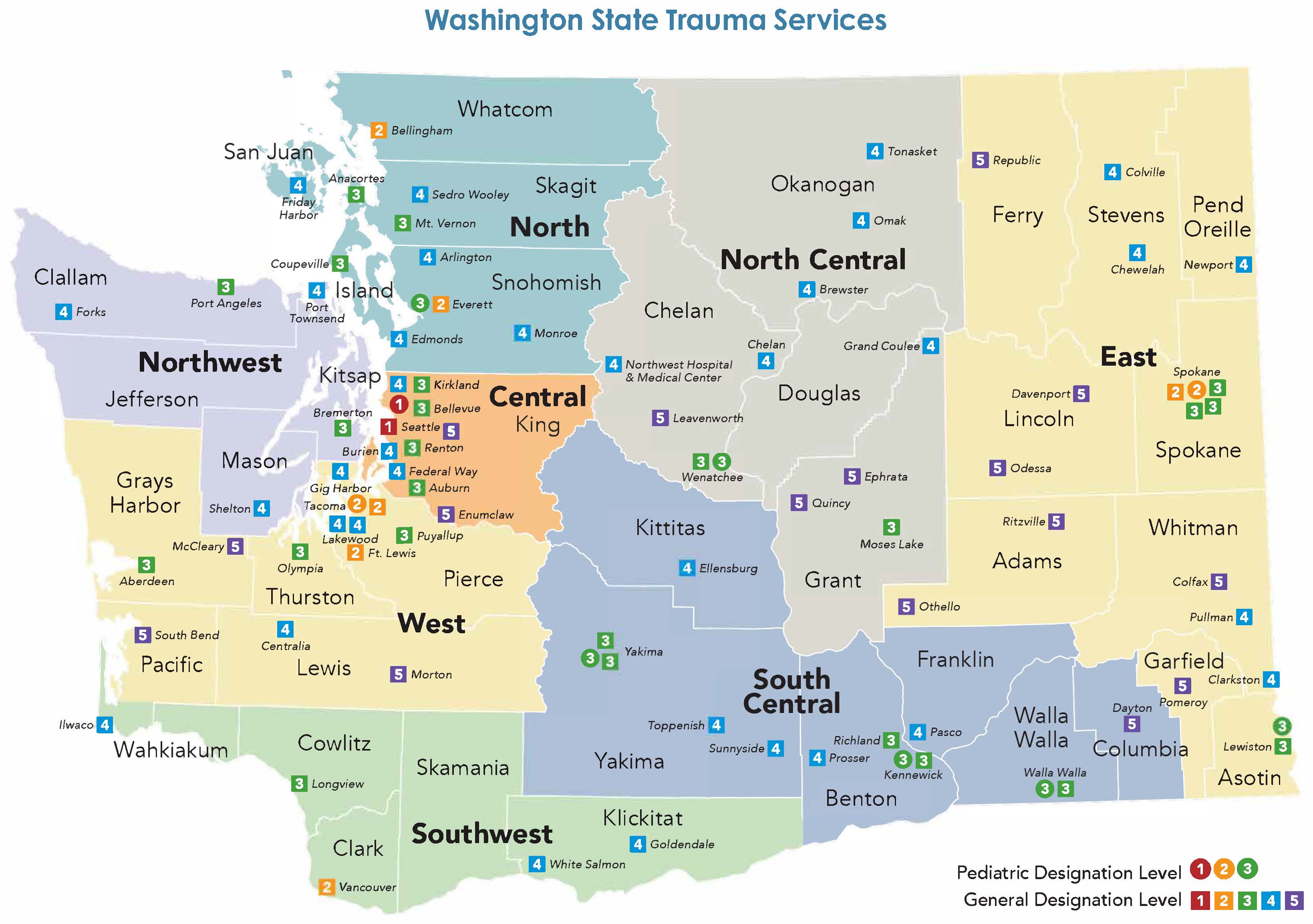
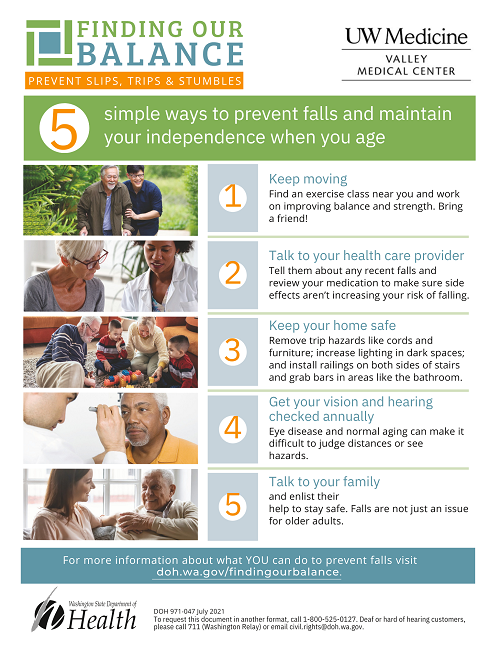 (Click to Enlarge)
(Click to Enlarge)